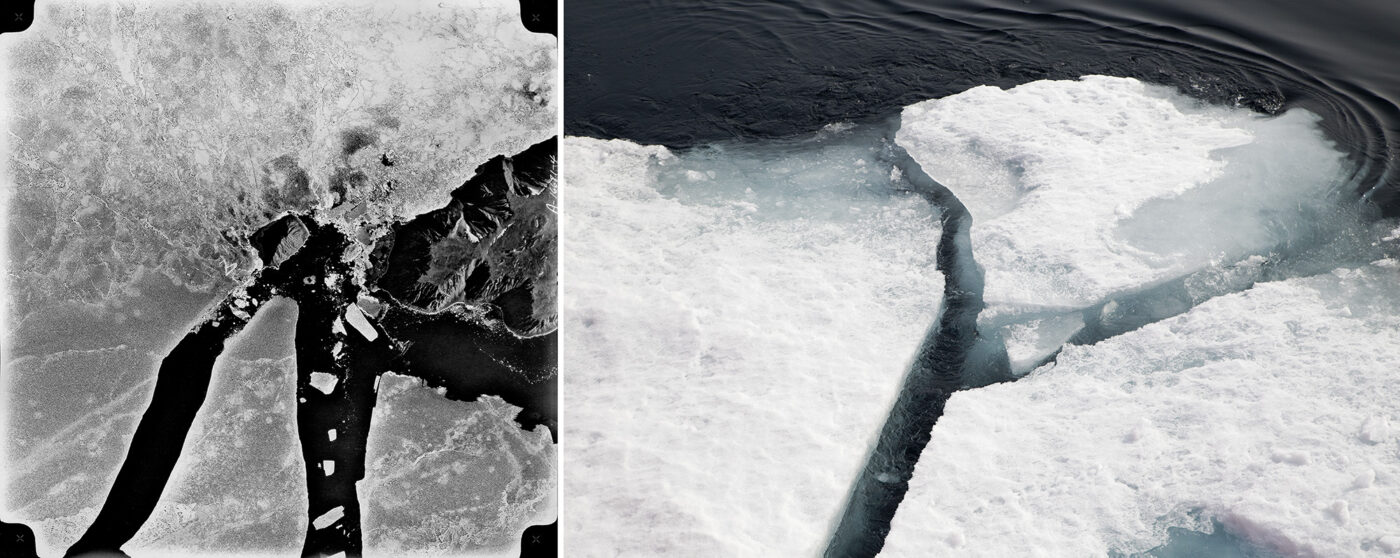Interview with Dark Ice Curator, Rebecca Basciano

Leslie Reid. Through Time, Through Space 2, 2020. Lightboxes, 68.58 x 68.58 cm; 68.58 x 96.52 cm. Archval aerial verticle black and white photograph: National Air Photo Library; taken for early mapping of the North, above King Edward Point, 1959. Colour photograph: Leslie Reid, taken from the deck of teh Canada C3 icebreaker, Franklin Strait, 2017.
The show explores climate change, community, and what happens when North and South come together. We caught up with exhibition curator, Rebecca Basciano from the Ottawa Art Gallery, who is in Winnipeg this weekend to give a Curator Talk on November 30 and Curator Tour on December 1 to delve deeper into the show.

Rebecca Basciano, Ottawa Art Gallery Curator
WAG: How did the idea for the exhibition come about?
RB: I was in conversations with Leslie Reid already at the Ottawa Art Gallery. She is well-known to the Ottawa arts community and was showing me some new work inspired by her trips up North and climate change. Neither of us wanted to tell this story of the North, climate change, and the people, without an Inuit perspective so we began reaching out to folks for suggestions and bouncing names around. I ended up reaching out to Robert Kautuk who I had been following online for a few years and he came on board right away. From there it became a two person show. Robert’s work focused on his community, land-based practices, and Inuit knowledge. Their processes are similar but the perspectives are different, and together, they created a unified story.
WAG: What inspired you to pair Robert and Leslie’s work for an exhibition?
RB: I hadn’t met Robert before but I loved his work. This exhibition was one of the first times Robert featured his photographs in a gallery. Previously his work had been seen through magazines and online. We invited Robert to do an artist residency in Ottawa where he printed his work and used light boxes to backlight his photos. He really liked that outcome. During this residency, Leslie and Robert also participated in the exhibition layout process. It wasn’t until then that they got to see how well their works talk to each other. At that point, they collaborated on the banner – one side is Leslie, one side is Robert. There are a few instances where it is hard to differentiate if the work was done by Leslie or Robert. Their art just pairs so well and works in conversation together.
WAG: Were you always interested in the environment?
RB: Yes, this is a topic I’ve been trying to work through curatorially for some time. We’re asking questions like ‘what does environmental art or practice look like?’ and ‘how do you engage with climate change in a gallery?’ It’s a learning process. In this exhibition, the labels help to address the context behind the photographs and dissect these difficult conversations and information, gained through interviews with the artists.
WAG: What do you think a gallery’s role is when it comes to climate change?
RB: I think galleries are a place for discussion, a place for action, a place to think about your impact, and how we can make small and big changes collectively. The exhibition brings to light the different perspectives of climate change, interlaced with so many other issues like colonization and knowledge sharing. It’s a complex issue. The only way to combat the problem is to pick at the threads one by one and do it together.
WAG: You brought this show to Nunatta Sunakkutaangit Museum in Iqaluit. What was the reception like there?
RB: It was a great experience, for me personally, to bring Inuit and settler art and perspectives together in conversation. That was always the vision for the show as well as the tour – that it had to be shared with both Northern and Southern audiences. OAG and the WAG are vast and open like a Northern landscape, but the Nunatta Sunakkutaangit Museum is smaller and condensed, which allowed for a more intimate and embodied experience with the artworks. The show was well received there. They sold out catalogues and their staff was really pleased.
WAG: Have you noticed any interesting conversations that have popped up in the show’s various venues?
RB: I’ve heard conversations about how warm the exhibition feels for being pictures of ice. The photos in some cases are printed on aluminum, on fabric banners, or projected with light. The materiality really plays a role in the show and also plays into the overall theme of the exhibition. The delicate banners depict fragile ecosystems, echoing the fragility caused by colonization. I really liked the sense of movement, the stable but unstable, unthreatening but threatening, the beautiful but challenging stories. The contrasts in the show to me are really important parts of the conversation.
WAG: What do you hope people take away from the exhibition?
RB: I hope for meaningful consultation with Indigenous communities when it comes to climate action – I think that is imperative. In 2017 there was seismic testing in Clyde River that was disturbing the wildlife and hunting in the community. The community took the issue to the Supreme Court and won. They took the matter into their own hands, which is what I hope people will do in regards to their own actions towards climate change.
See the exhibition on view now at WAG-Qaumajuq until May 26, 2024 and pick up the catalogue at ShopWAG for in depth interviews and essays with the artists and curator.
More Stories
To plan your visit, check out wag.ca/visit.
